Basura Fernando
CoFFT: Chain of Foresight-Focus Thought for Visual Language Models
Sep 26, 2025Abstract:Despite significant advances in Vision Language Models (VLMs), they remain constrained by the complexity and redundancy of visual input. When images contain large amounts of irrelevant information, VLMs are susceptible to interference, thus generating excessive task-irrelevant reasoning processes or even hallucinations. This limitation stems from their inability to discover and process the required regions during reasoning precisely. To address this limitation, we present the Chain of Foresight-Focus Thought (CoFFT), a novel training-free approach that enhances VLMs' visual reasoning by emulating human visual cognition. Each Foresight-Focus Thought consists of three stages: (1) Diverse Sample Generation: generates diverse reasoning samples to explore potential reasoning paths, where each sample contains several reasoning steps; (2) Dual Foresight Decoding: rigorously evaluates these samples based on both visual focus and reasoning progression, adding the first step of optimal sample to the reasoning process; (3) Visual Focus Adjustment: precisely adjust visual focus toward regions most beneficial for future reasoning, before returning to stage (1) to generate subsequent reasoning samples until reaching the final answer. These stages function iteratively, creating an interdependent cycle where reasoning guides visual focus and visual focus informs subsequent reasoning. Empirical results across multiple benchmarks using Qwen2.5-VL, InternVL-2.5, and Llava-Next demonstrate consistent performance improvements of 3.1-5.8\% with controllable increasing computational overhead.
ChainReaction! Structured Approach with Causal Chains as Intermediate Representations for Improved and Explainable Causal Video Question Answering
Aug 28, 2025Abstract:Existing Causal-Why Video Question Answering (VideoQA) models often struggle with higher-order reasoning, relying on opaque, monolithic pipelines that entangle video understanding, causal inference, and answer generation. These black-box approaches offer limited interpretability and tend to depend on shallow heuristics. We propose a novel, modular framework that explicitly decouples causal reasoning from answer generation, introducing natural language causal chains as interpretable intermediate representations. Inspired by human cognitive models, these structured cause-effect sequences bridge low-level video content with high-level causal reasoning, enabling transparent and logically coherent inference. Our two-stage architecture comprises a Causal Chain Extractor (CCE) that generates causal chains from video-question pairs, and a Causal Chain-Driven Answerer (CCDA) that produces answers grounded in these chains. To address the lack of annotated reasoning traces, we introduce a scalable method for generating high-quality causal chains from existing datasets using large language models. We also propose CauCo, a new evaluation metric for causality-oriented captioning. Experiments on three large-scale benchmarks demonstrate that our approach not only outperforms state-of-the-art models, but also yields substantial gains in explainability, user trust, and generalization -- positioning the CCE as a reusable causal reasoning engine across diverse domains. Project page: https://paritoshparmar.github.io/chainreaction/
Neuro Symbolic Knowledge Reasoning for Procedural Video Question Answering
Mar 19, 2025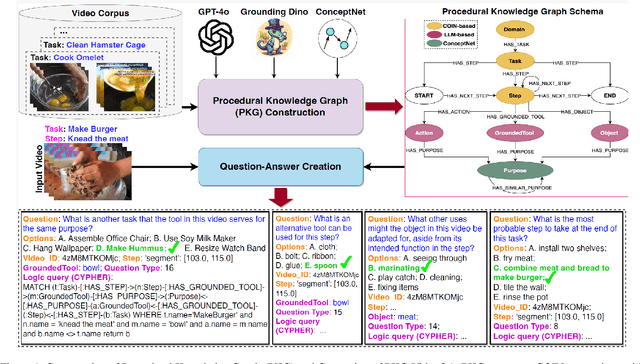
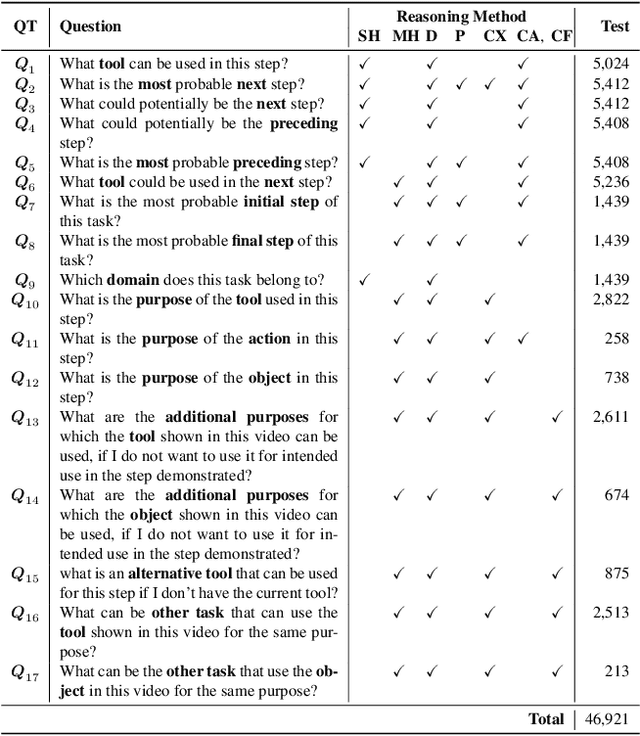

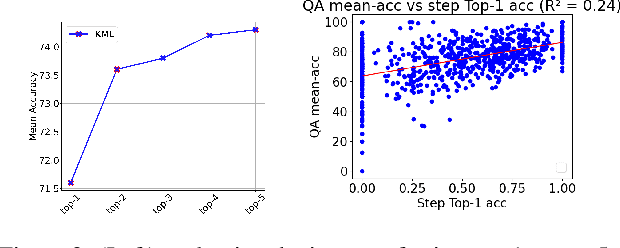
Abstract:This paper introduces a new video question-answering (VQA) dataset that challenges models to leverage procedural knowledge for complex reasoning. It requires recognizing visual entities, generating hypotheses, and performing contextual, causal, and counterfactual reasoning. To address this, we propose neuro symbolic reasoning module that integrates neural networks and LLM-driven constrained reasoning over variables for interpretable answer generation. Results show that combining LLMs with structured knowledge reasoning with logic enhances procedural reasoning on the STAR benchmark and our dataset. Code and dataset at https://github.com/LUNAProject22/KML soon.
Learning to Generate Long-term Future Narrations Describing Activities of Daily Living
Mar 03, 2025Abstract:Anticipating future events is crucial for various application domains such as healthcare, smart home technology, and surveillance. Narrative event descriptions provide context-rich information, enhancing a system's future planning and decision-making capabilities. We propose a novel task: $\textit{long-term future narration generation}$, which extends beyond traditional action anticipation by generating detailed narrations of future daily activities. We introduce a visual-language model, ViNa, specifically designed to address this challenging task. ViNa integrates long-term videos and corresponding narrations to generate a sequence of future narrations that predict subsequent events and actions over extended time horizons. ViNa extends existing multimodal models that perform only short-term predictions or describe observed videos by generating long-term future narrations for a broader range of daily activities. We also present a novel downstream application that leverages the generated narrations called future video retrieval to help users improve planning for a task by visualizing the future. We evaluate future narration generation on the largest egocentric dataset Ego4D.
PhysReason: A Comprehensive Benchmark towards Physics-Based Reasoning
Feb 17, 2025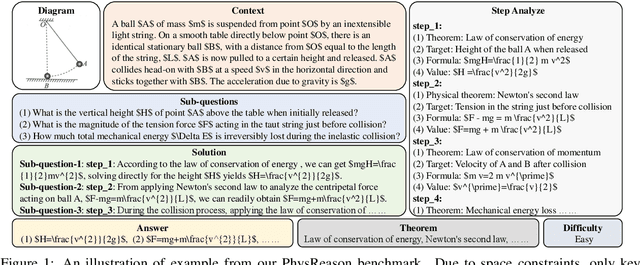
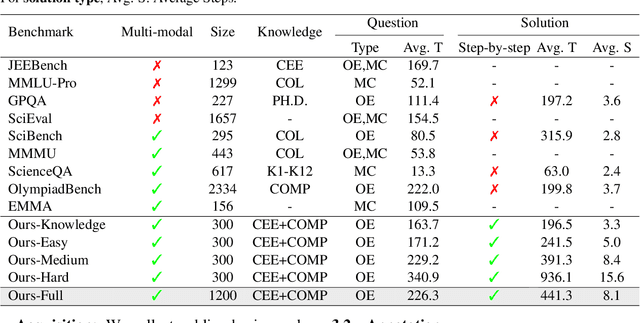


Abstract:Large language models demonstrate remarkable capabilities across various domains, especially mathematics and logic reasoning. However, current evaluations overlook physics-based reasoning - a complex task requiring physics theorems and constraints. We present PhysReason, a 1,200-problem benchmark comprising knowledge-based (25%) and reasoning-based (75%) problems, where the latter are divided into three difficulty levels (easy, medium, hard). Notably, problems require an average of 8.1 solution steps, with hard requiring 15.6, reflecting the complexity of physics-based reasoning. We propose the Physics Solution Auto Scoring Framework, incorporating efficient answer-level and comprehensive step-level evaluations. Top-performing models like Deepseek-R1, Gemini-2.0-Flash-Thinking, and o3-mini-high achieve less than 60% on answer-level evaluation, with performance dropping from knowledge questions (75.11%) to hard problems (31.95%). Through step-level evaluation, we identified four key bottlenecks: Physics Theorem Application, Physics Process Understanding, Calculation, and Physics Condition Analysis. These findings position PhysReason as a novel and comprehensive benchmark for evaluating physics-based reasoning capabilities in large language models. Our code and data will be published at https:/dxzxy12138.github.io/PhysReason.
FedMLLM: Federated Fine-tuning MLLM on Multimodal Heterogeneity Data
Nov 22, 2024



Abstract:Multimodal Large Language Models (MLLMs) have made significant advancements, demonstrating powerful capabilities in processing and understanding multimodal data. Fine-tuning MLLMs with Federated Learning (FL) allows for expanding the training data scope by including private data sources, thereby enhancing their practical applicability in privacy-sensitive domains. However, current research remains in the early stage, particularly in addressing the \textbf{multimodal heterogeneities} in real-world applications. In this paper, we introduce a benchmark for evaluating various downstream tasks in the federated fine-tuning of MLLMs within multimodal heterogeneous scenarios, laying the groundwork for the research in the field. Our benchmark encompasses two datasets, five comparison baselines, and four multimodal scenarios, incorporating over ten types of modal heterogeneities. To address the challenges posed by modal heterogeneity, we develop a general FedMLLM framework that integrates four representative FL methods alongside two modality-agnostic strategies. Extensive experimental results show that our proposed FL paradigm improves the performance of MLLMs by broadening the range of training data and mitigating multimodal heterogeneity. Code is available at https://github.com/1xbq1/FedMLLM
Learning to Reason Iteratively and Parallelly for Complex Visual Reasoning Scenarios
Nov 20, 2024Abstract:Complex visual reasoning and question answering (VQA) is a challenging task that requires compositional multi-step processing and higher-level reasoning capabilities beyond the immediate recognition and localization of objects and events. Here, we introduce a fully neural Iterative and Parallel Reasoning Mechanism (IPRM) that combines two distinct forms of computation -- iterative and parallel -- to better address complex VQA scenarios. Specifically, IPRM's "iterative" computation facilitates compositional step-by-step reasoning for scenarios wherein individual operations need to be computed, stored, and recalled dynamically (e.g. when computing the query "determine the color of pen to the left of the child in red t-shirt sitting at the white table"). Meanwhile, its "parallel" computation allows for the simultaneous exploration of different reasoning paths and benefits more robust and efficient execution of operations that are mutually independent (e.g. when counting individual colors for the query: "determine the maximum occurring color amongst all t-shirts"). We design IPRM as a lightweight and fully-differentiable neural module that can be conveniently applied to both transformer and non-transformer vision-language backbones. It notably outperforms prior task-specific methods and transformer-based attention modules across various image and video VQA benchmarks testing distinct complex reasoning capabilities such as compositional spatiotemporal reasoning (AGQA), situational reasoning (STAR), multi-hop reasoning generalization (CLEVR-Humans) and causal event linking (CLEVRER-Humans). Further, IPRM's internal computations can be visualized across reasoning steps, aiding interpretability and diagnosis of its errors.
Situational Scene Graph for Structured Human-centric Situation Understanding
Oct 30, 2024Abstract:Graph based representation has been widely used in modelling spatio-temporal relationships in video understanding. Although effective, existing graph-based approaches focus on capturing the human-object relationships while ignoring fine-grained semantic properties of the action components. These semantic properties are crucial for understanding the current situation, such as where does the action takes place, what tools are used and functional properties of the objects. In this work, we propose a graph-based representation called Situational Scene Graph (SSG) to encode both human-object relationships and the corresponding semantic properties. The semantic details are represented as predefined roles and values inspired by situation frame, which is originally designed to represent a single action. Based on our proposed representation, we introduce the task of situational scene graph generation and propose a multi-stage pipeline Interactive and Complementary Network (InComNet) to address the task. Given that the existing datasets are not applicable to the task, we further introduce a SSG dataset whose annotations consist of semantic role-value frames for human, objects and verb predicates of human-object relations. Finally, we demonstrate the effectiveness of our proposed SSG representation by testing on different downstream tasks. Experimental results show that the unified representation can not only benefit predicate classification and semantic role-value classification, but also benefit reasoning tasks on human-centric situation understanding. We will release the code and the dataset soon.
Cross-Modal Few-Shot Learning: a Generative Transfer Learning Framework
Oct 14, 2024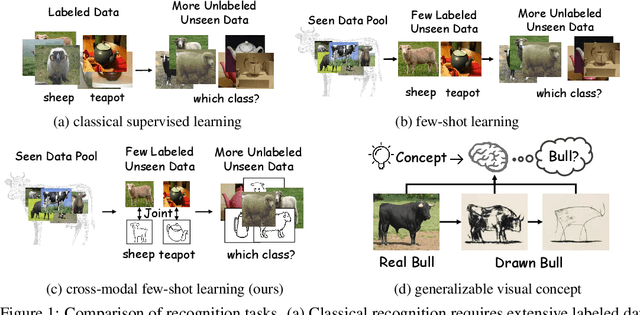



Abstract:Most existing studies on few-shot learning focus on unimodal settings, where models are trained to generalize on unseen data using only a small number of labeled examples from the same modality. However, real-world data are inherently multi-modal, and unimodal approaches limit the practical applications of few-shot learning. To address this gap, this paper introduces the Cross-modal Few-Shot Learning (CFSL) task, which aims to recognize instances from multiple modalities when only a few labeled examples are available. This task presents additional challenges compared to classical few-shot learning due to the distinct visual characteristics and structural properties unique to each modality. To tackle these challenges, we propose a Generative Transfer Learning (GTL) framework consisting of two stages: the first stage involves training on abundant unimodal data, and the second stage focuses on transfer learning to adapt to novel data. Our GTL framework jointly estimates the latent shared concept across modalities and in-modality disturbance in both stages, while freezing the generative module during the transfer phase to maintain the stability of the learned representations and prevent overfitting to the limited multi-modal samples. Our finds demonstrate that GTL has superior performance compared to state-of-the-art methods across four distinct multi-modal datasets: Sketchy, TU-Berlin, Mask1K, and SKSF-A. Additionally, the results suggest that the model can estimate latent concepts from vast unimodal data and generalize these concepts to unseen modalities using only a limited number of available samples, much like human cognitive processes.
Effectively Leveraging CLIP for Generating Situational Summaries of Images and Videos
Jul 30, 2024



Abstract:Situation recognition refers to the ability of an agent to identify and understand various situations or contexts based on available information and sensory inputs. It involves the cognitive process of interpreting data from the environment to determine what is happening, what factors are involved, and what actions caused those situations. This interpretation of situations is formulated as a semantic role labeling problem in computer vision-based situation recognition. Situations depicted in images and videos hold pivotal information, essential for various applications like image and video captioning, multimedia retrieval, autonomous systems and event monitoring. However, existing methods often struggle with ambiguity and lack of context in generating meaningful and accurate predictions. Leveraging multimodal models such as CLIP, we propose ClipSitu, which sidesteps the need for full fine-tuning and achieves state-of-the-art results in situation recognition and localization tasks. ClipSitu harnesses CLIP-based image, verb, and role embeddings to predict nouns fulfilling all the roles associated with a verb, providing a comprehensive understanding of depicted scenarios. Through a cross-attention Transformer, ClipSitu XTF enhances the connection between semantic role queries and visual token representations, leading to superior performance in situation recognition. We also propose a verb-wise role prediction model with near-perfect accuracy to create an end-to-end framework for producing situational summaries for out-of-domain images. We show that situational summaries empower our ClipSitu models to produce structured descriptions with reduced ambiguity compared to generic captions. Finally, we extend ClipSitu to video situation recognition to showcase its versatility and produce comparable performance to state-of-the-art methods.
 Add to Chrome
Add to Chrome Add to Firefox
Add to Firefox Add to Edge
Add to Edge